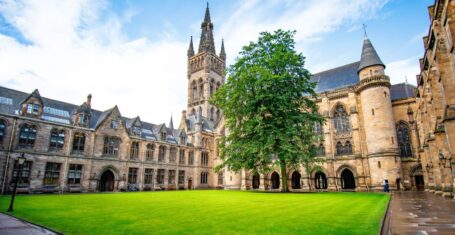
The Oxbridge courses where you’ll find the most girlies in 2024
Men apparently hate history of art
Girl, it’s so confusing to apply to Oxbridge. We’ve ranked all the Oxbridge courses by the percentage of girls studying there in 2024, so you know what to pick if you want to be surrounded by other girlies. Working this out took some serious girl math.
There is a massive split between how many girls do STEM and humanities courses at Oxbridge in 2024. There is such a lack of women in STEM at Oxbridge that it makes me despair for feminism. At Cambridge, 62.2 per cent of humanities students are female, and 38.7 per cent are male. It tends to be the “softer” STEM subjects that have more girls – such as psychology and veterinary science – and the “tougher” humanities subjects – such as law and politics – which have more men. Mathematics and computer science at Oxford has the least female students. There are 48 male and three female freshers on that course right now.
The overall gender divide for Oxbridge is pretty even – 50.4 per cent of Cambridge students and 49.7 per cent of Oxford students identify as female. This is pretty low for Russell Group unis – more girls get into Russell Group unis than boys.
These stats come from Cambridge and Oxford’s websites and refer to the year group who are freshers right now. Religion and Asian and Middle Eastern studies at Oxford just has one student this year, who is female.
So, here are all the Oxbridge courses ranked by the percentage of girls studying them in 2024:
79. Mathematics and computer science, Oxford – 5.9 per cent
78. Mathematics, Cambridge – 19.4 per cent
77. Engineering science, Oxford – 20.9 per cent
76. Physics, Oxford – 21.3 per cent
75. Computer science, Cambridge – 21.5 per cent
Most Read
=73. Engineering, Cambridge – 24.0 per cent
=73. Mathematics, Oxford – 24.0 per cent
72. Computer science, Oxford – 30.8 per cent
71. Chemical engineering and biotechnology, Cambridge – 31.3 per cent
70. Mathematics and philosophy, Oxford – 31.6 per cent
69. Computer science and philosophy, Oxford – 33.3 per cent
68. Economics, Cambridge – 35.2 per cent
67. Economics and management, Oxford – 36.1 per cent
66. History and politics, Oxford – 37.5 per cent
65. Chemistry, Oxford – 38.3 per cent
64. Materials science, Oxford – 38.6 per cent
63. History and economics, Oxford – 38.9 per cent
62. Ancient and modern history, Oxford – 40.0 per cent
61. Philosophy, politics and economics (PPE), Oxford – 40.6 per cent
60. Land economy, Cambridge – 42.3 per cent

A rare sight: a girl in a Cambridge science lecture
59. Natural sciences, Cambridge – 42.8 per cent
58. Music, Oxford – 44.4 per cent
57. Theology and religion, Oxford – 45.7 per cent
56. Linguistics, Cambridge – 46.2 per cent
=54. History and English, Oxford – 50.0 per cent
=54. Physics and philosophy, Oxford – 50.0 per cent
=52. Law, Cambridge – 51.3 per cent
=52. Medicine, Cambridge – 51.3 per cent
51. Philosophy, Cambridge – 52.0 per cent
50. History and politics, Cambridge – 52.2 per cent
49. Medicine, Oxford – 52.3 per cent
48. Philosophy and modern languages, Oxford – 52.4 per cent
47. Earth sciences, Oxford – 52.9 per cent
=45. European and Middle Eastern languages, Oxford – 53.8 per cent
=45. Law studies in Europe, Oxford – 53.8 per cent
44. Geography, Oxford – 55.7 per cent
43. Philosophy and theology, Oxford – 56.0 per cent
42. History, Oxford – 57.0 per cent
41. Fine art, Oxford – 57.1 per cent

Oxbridge students do leave the library on occasion
40. Medicine graduate course, Cambridge – 57.5 per cent
39. Classics, Oxford – 59.0 per cent
=37. Architecture, Cambridge – 60.0 per cent
=37. Asian and Middle Eastern studies, Oxford – 60.0 per cent
36. History and modern languages, Oxford – 61.1 per cent
=34. Biology, Oxford – 61.5 per cent
=34. Human sciences, Oxford – 61.5 per cent
33. Law, Oxford – 62.0 per cent
32. Music, Cambridge – 62.7 per cent
31. Biochemistry, Oxford – 63.0 per cent
30. Archaeololgy and anthropology, Oxford – 63.6 per cent
29. Human, social and political sciences (HSPS), Cambridge – 63.9 per cent
28. History and modern languages, Cambridge – 64.5 per cent
27. Modern languages, Oxford – 65.5 per cent
26. Modern and medieval languages (MML), Cambridge – 66.4 per cent
25. Mathematics and statistics, Oxford – 66.7 per cent
24. Asian and Middle Eastern studies (AMES), Cambridge – 67.5 per cent
23. History, Cambridge – 67.7 per cent
22. Anglo Saxon, Norse and Celtic studies (ASNAC), Cambridge – 68.4 per cent
21. Geography, Cambridge – 68.7 per cent
20. Biomedical sciences, Oxford – 70.7 per cent
=18. Classical archaeology and anthropology, Oxford – 72.0 per cent
=18. Classics (three years), Cambridge – 72.0 per cent

Plenty of girlies pick Classics and history of art
17. Psychological and behavioural sciences, Cambridge – 72.8 per cent
16. Psychology, philosophy and linguistics, Oxford – 73.7 per cent
=14. Experimental psychology, Oxford – 74.4 per cent
=14. Modern languages and linguistics, Oxford – 74.4 per cent
13. Classics (four years), Cambridge – 75.9 per cent
12. English language and literature, Oxford – 77.8 per cent
11. History of art, Oxford – 78.6 per cent
10. English, Cambridge – 79.7 per cent
9. Theology, religion and philosophy of religion, Cambridge – 81.1 per cent
8. Archaeology, Cambridge – 81.3 per cent
7. Education, Cambridge – 82.4 per cent
6. Veterinary medicines, Cambridge – 83.6 per cent
5. Classics and English, Oxford – 84.6 per cent
4. English and modern languages, Oxford – 85.7 per cent
3. Classics and modern languages, Oxford – 90.0 per cent
2. History of art, Cambridge – 96.8 per cent
1. Religion and Asian and Middle Eastern studies, Oxford – 100.0 per cent















